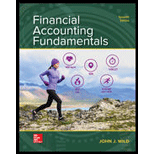
Concept explainers
1.
Financial statement analysis:
Company and its users use financial analysis as a way to analyse the company’s financial statements to take investment and business decisions. Some of the common financial analysis techniques include ratio analysis, vertical analysis, horizontal analysis, time series analysis etc.
Outstanding common shares on each cash dividend date.
1.
Explanation of Solution
| Date | No. of outstanding shares |
| Feb 15 | 17,000 shares |
| May 15 | 16,000 shares |
| Aug 15 | 16,000 shares |
| Nov 15 | 18,000 shares |
Feb 15: As per the beginning data, 17,000 shares are issued and outstanding. So, outstanding shares on Feb 15 will be 17,000 and dividend will be paid on same number of shares.
May 15:
Aug15: No transactions took place between May15 and Aug 15. Thus, number of outstanding shares remain same.
Nov 15: 12.5% stock dividend was released on Oct 20. So, number of outstanding shares will increase by 12.5%. This means total outstanding shares would be 18,000.
2.
Financial statement analysis:
Company and its users use financial analysis as a way to analyse the company’s financial statements to take investment and business decisions. Some of the common financial analysis techniques include ratio analysis, vertical analysis, horizontal analysis, time series analysis etc.
To compute:Amount of cash dividend on each of the four dividend dates.
2.
Explanation of Solution
As computed above,
| Date | No. of outstanding shares |
| Feb 15 | 17,000 shares |
| May 15 | 16,000 shares |
| Aug 15 | 16,000 shares |
| Nov 15 | 18,000 shares |
Considering dividend per share, total cash dividend on each date can be computed as:
| Date | No. of outstanding shares (i) | Dividend per share (ii) | Total cash dividend[(i)*(ii)] |
| Feb 15 | 17,000 shares | $0.40 | $6,800 |
| May 15 | 16,000 shares | $0.40 | $6,400 |
| Aug 15 | 16,000 shares | $0.40 | $6,400 |
| Nov 15 | 18,000 shares | $0.40 | $7,200 |
3.
Financial statement analysis:
Company and its users use financial analysis as a way to analyse the company’s financial statements to take investment and business decisions. Some of the common financial analysis techniques include ratio analysis, vertical analysis, horizontal analysis, time series analysis etc.
To compute:
3.
Explanation of Solution
Stock dividend is declaring dividend of stock to existing shareholders. It has no impact on total
Given:
No. of shares outstanding, before declaring stock dividend = 16,000
Stock dividend declared = 12.5%
Market value of share = $42
Now, number of shares issued as stock dividend can be computed as:
Stock dividend shares = No. of shares outstanding*Stock dividend declared
Stock dividend shares = 16,000*12.5%
Stock dividend shares = 2,000
Amount to be transferred from retained earnings can be computed as:
Value of stock dividend = Stock dividend shares*Market value of share
Value of stock dividend = 2,000*$42
Value of stock dividend = $84,000
4.
Financial statement analysis:
Company and its users use financial analysis as a way to analyse the company’s financial statements to take investment and business decisions. Some of the common financial analysis techniques include ratio analysis, vertical analysis, horizontal analysis, time series analysis etc.
To compute:Per share cost of treasury stock.
4.
Explanation of Solution
Treasury stock is created when the company purchases its own shares from the market. It is shown as a part of issued shares but are not counted in outstanding shares as they are held by the company.
Given:
No. of shares in treasury stock = 1,000
Cost of treasury stock = $40,000
Cost per share of treasury stock can be computed as:
Cost of treasury stock, per share = Cost of treasury stock/No. of shares in treasury stock
Cost of treasury stock, per share = $40,000/1,000
Cost of treasury stock, per share = $40
5.
Financial statement analysis:
Company and its users use financial analysis as a way to analyse the company’s financial statements to take investment and business decisions. Some of the common financial analysis techniques include ratio analysis, vertical analysis, horizontal analysis, time series analysis etc.
To compute:Net income earned during the year.
5.
Explanation of Solution
Net income can be computed as:
| Particulars | $ |
| Retained earnings, closing | 295,200 |
| Less: Retained earnings, beginning | (270,000) |
| Add: Cash dividend | 26,800 |
| Add: Stock dividend | 84,000 |
| Net income | 136,000 |
Workings:
As computed, total cash dividend can be calculated as:
| Date | Total cash dividend |
| Feb 15 | $6,800 |
| May 15 | $6,400 |
| Aug 15 | $6,400 |
| Nov 15 | $7,200 |
| $26,800 |
Also, stock dividend worth $84,000 is transferred from retained earnings to paid-in capital for stock dividend.
Want to see more full solutions like this?
Chapter 11 Solutions
FINANCIAL ACCT.FUND.(LOOSELEAF)
- Please provide the accurate solution to this financial accounting question using valid calculations.arrow_forwardPlease help me solve this financial accounting question using the right financial principles.arrow_forwardI need help finding the accurate solution to this general accounting problem with valid methods.arrow_forward
- Can you solve this general accounting problem with appropriate steps and explanations?arrow_forwardI am searching for the accurate solution to this general accounting problem with the right approach.arrow_forwardI am searching for the accurate solution to this general accounting problem with the right approach.arrow_forward
 Financial AccountingAccountingISBN:9781337272124Author:Carl Warren, James M. Reeve, Jonathan DuchacPublisher:Cengage Learning
Financial AccountingAccountingISBN:9781337272124Author:Carl Warren, James M. Reeve, Jonathan DuchacPublisher:Cengage Learning Financial Accounting: The Impact on Decision Make...AccountingISBN:9781305654174Author:Gary A. Porter, Curtis L. NortonPublisher:Cengage Learning
Financial Accounting: The Impact on Decision Make...AccountingISBN:9781305654174Author:Gary A. Porter, Curtis L. NortonPublisher:Cengage Learning Survey of Accounting (Accounting I)AccountingISBN:9781305961883Author:Carl WarrenPublisher:Cengage Learning
Survey of Accounting (Accounting I)AccountingISBN:9781305961883Author:Carl WarrenPublisher:Cengage Learning Cornerstones of Financial AccountingAccountingISBN:9781337690881Author:Jay Rich, Jeff JonesPublisher:Cengage LearningCentury 21 Accounting Multicolumn JournalAccountingISBN:9781337679503Author:GilbertsonPublisher:Cengage
Cornerstones of Financial AccountingAccountingISBN:9781337690881Author:Jay Rich, Jeff JonesPublisher:Cengage LearningCentury 21 Accounting Multicolumn JournalAccountingISBN:9781337679503Author:GilbertsonPublisher:Cengage





